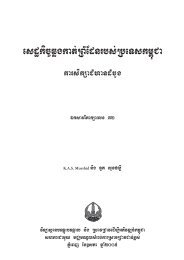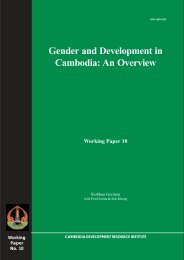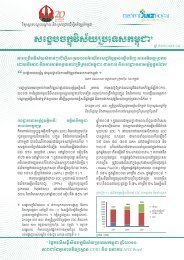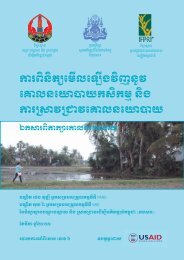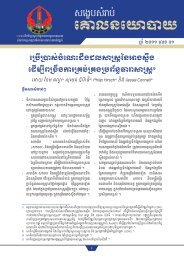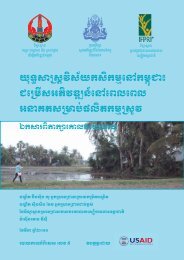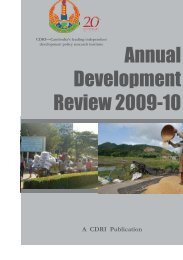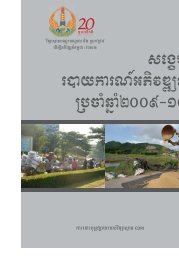62) decentralised governance of irrigation water in cambodia - CDRI
62) decentralised governance of irrigation water in cambodia - CDRI
62) decentralised governance of irrigation water in cambodia - CDRI
Create successful ePaper yourself
Turn your PDF publications into a flip-book with our unique Google optimized e-Paper software.
CHAPTER 4 CASE STUDY SITES<br />
4.1 Rolous Scheme<br />
Rolous <strong>irrigation</strong> scheme is located about 7 km to the west <strong>of</strong> Stung Sen Town (the<br />
prov<strong>in</strong>cial capital <strong>of</strong> Kampong Thom prov<strong>in</strong>ce). It is typical <strong>of</strong> a shallow bundled reservoir.<br />
Water flows <strong>in</strong>to the scheme through five areas: Po Bakrong Bridge, Balang dra<strong>in</strong>age pipe,<br />
Tbong Cham Bridge, Prek (stream) Sbove, and Prek O Lok (Figure 2). Stung Sen, Prek Sbove<br />
and Chong Mong streams contribute the largest proportion <strong>of</strong> <strong>water</strong> to the scheme. The command<br />
area <strong>of</strong> the scheme is about 1,009 ha; it crosses seven villages and four sangkats/communes 4 : O<br />
Kunthor, Kampong Rotes, Damrey Cheankla and Sroyov. There are three topographic levels <strong>of</strong><br />
paddy land <strong>in</strong> the Rolous scheme. The lowest level rice paddies are <strong>in</strong> the south-west, the midlevel<br />
paddies are around the centre <strong>of</strong> the scheme and the highest level paddies are <strong>in</strong> the east.<br />
Figure 2: Map <strong>of</strong> the Rolous Irrigation Scheme and In-depth Study Site<br />
A 4 km long dam was built <strong>in</strong> 1969 to store <strong>water</strong> for agriculture <strong>in</strong> the Rolous command<br />
area. In 2004, it was rehabilitated by Social Bus<strong>in</strong>ess Khmer (SBK) Research and Development<br />
and has seven “gates” or head-structures, two dra<strong>in</strong>age pipes and 13 regulators. Rolous is<br />
considered a medium-scale <strong>irrigation</strong> scheme and it benefits approximately 882 households.<br />
Ma<strong>in</strong>, secondary and tertiary <strong>irrigation</strong> canals with<strong>in</strong> the system were built dur<strong>in</strong>g the Khmer<br />
Rouge regime (1975-1979) and have s<strong>in</strong>ce deteriorated due to lack <strong>of</strong> regular ma<strong>in</strong>tenance<br />
and repair. These canals were severely damaged by the Ketsana storm <strong>in</strong> September 2009. The<br />
seven head-structures are used to control the flow <strong>of</strong> <strong>water</strong> <strong>in</strong>to the scheme. These gates are<br />
closed dur<strong>in</strong>g the wet-season to store <strong>water</strong> for use dur<strong>in</strong>g the dry-season.<br />
4 Data collected from the annual report 2010 <strong>of</strong> Social Bus<strong>in</strong>ess Khmer (SBK) Research and Development.<br />
<strong>CDRI</strong> Work<strong>in</strong>g Paper Series No. <strong>62</strong><br />
13



